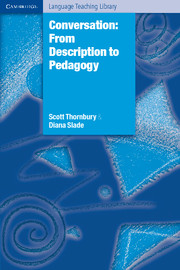Book contents
- Frontmatter
- Contents
- Thanks and acknowledgements
- Dedication
- Introduction
- 1 Characterizing conversation
- 2 The vocabulary of conversation
- 3 The grammar of conversation
- 4 The discourse features of conversation
- 5 Genres in conservation: Storytelling and gossiping
- 6 Acquiring L1 conversational competence
- 7 Acquiring L2 conversational competence
- 8 Teaching conversation: A history
- 9 Teaching conversation: Approach, design, procedure and process
- Task key
- References
- Author index
- Subject index
2 - The vocabulary of conversation
Published online by Cambridge University Press: 04 May 2010
- Frontmatter
- Contents
- Thanks and acknowledgements
- Dedication
- Introduction
- 1 Characterizing conversation
- 2 The vocabulary of conversation
- 3 The grammar of conversation
- 4 The discourse features of conversation
- 5 Genres in conservation: Storytelling and gossiping
- 6 Acquiring L1 conversational competence
- 7 Acquiring L2 conversational competence
- 8 Teaching conversation: A history
- 9 Teaching conversation: Approach, design, procedure and process
- Task key
- References
- Author index
- Subject index
Summary
Introduction
What characterizes the vocabulary of conversation? For example, how many words do speakers typically use? What distinguishes the lexis of casual conversation from more formal and less spontaneous forms of spoken language, and from written language? How many – and which – words do you need, to be able to take part in conversations in a second language? These are some of the main issues dealt with in this chapter. The point needs to be made, however, that the notion of vocabulary item is going to be stretched to include not only single words, but groups of words, and not only lexical items (such as those that would be included in a learner's vocabulary list) but items that have a grammatical or discoursal function. This expanded notion of lexis is in keeping with current thinking that views the boundaries between grammar and lexis, and between discourse and grammar, as fuzzy in the extreme. Nevertheless, for convenience, this chapter groups a variety of conversational phenomena under the general term vocabulary.
Much of the evidence for the description that follows draws on the findings of corpus linguistics and so a brief outline of the principles and goals of this discipline is in order. A corpus (plural corpora) is a collection of actually occurring texts (either spoken or written), stored and accessed by means of computers, and available for study and analysis by grammarians, lexicographers, teachers and language learners. Corpora can vary in size from fewer than a million words to several hundreds of millions (as is the case with both the COBUILD corpus and the British National Corpus (BNC)).
- Type
- Chapter
- Information
- ConversationFrom Description to Pedagogy, pp. 40 - 72Publisher: Cambridge University PressPrint publication year: 2006



